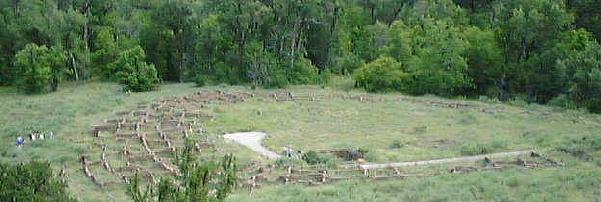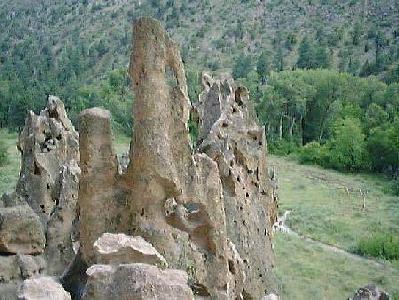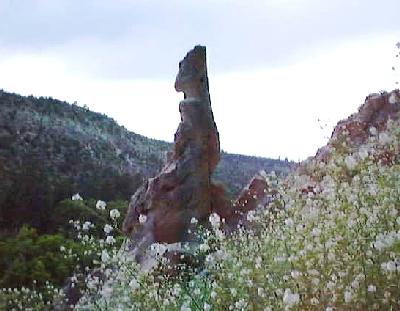
Bandelier National Monument

The ruins of Tyuonyi in Frijoles Cantion (the litle white spots on the extreme left are people)
Saturday 7th August 1999
Bandelier National Monument is a 50 square mile area densely packed with ruins of the Rio Grande Pueblo Indians. Several sites have been excavated, but over 2,400 have been identified, and only half of the monument has been surveyed! Not all of these sites were occupied at the same time, however. The main area we visited was the Frijoles Canyon.
The people who lived here are thought to have been descended from nomadic hunter-gatherers who arrived 10-12,000 years ago. For many generations, they lived in small dispersed settlements including just a few families. During what is sometimes called the Rio Grande Coalition Period (ca. 1150-1325 AD), the population increased, and the people began to live in larger settlements, pueblos with up to 40 rooms. From then until the late 1500s (when the Spanish colonised New Mexico), in what is called the Rio Grande Classical Period, the people lived in much larger settlements with upwards of 600 rooms. Tyuonyi and the Bandelier cliff dwellings belong to this period.

Rock formations in the Frijoles Canyon, Bandelier National Monument
Like Puye, the area of the Frijoles Canyon consists of soft volcanic tuff on a hard basalt base. Here, though, the greater presence of water has meant that there are some spectacular rock formations; not as epic in scale, certainly, as the Grand Canyon, but with some extraordinary forms and shapes. In the picture above, you can just make out the outline of Tyuonyi pueblo on the canyon floor in the background.

Above the canyon floor is a separate settlement, a series of cavata and talus buildings similar to Puye, but on a larger scale. Archaeological evidence suggests that these two sites were occupied by different groups of people, an idea that is borne out by the traditions of the people of the San Ildefonso Pueblo to the north-east and the Cochiti Pueblo to the south. The San Ildefonso Puebloans speak Tewa, while the Cochiti Puebloans speak Keres, and they both believe that they are the descendants of the people who left Bandelier in the 1500s.

The cliff dwellings at Bandelier
The cliff dwellings are reached by a narrow winding path through a gap in the tuff rock. As at Puye, many of the rooms are carved into the bare rock using stone or even wooden tools, and can only be accessed by climbing ladders. This would have enhanced the inhabitants' security, and also makes for an interesting visit.
Further along the canyon is the so-called ceremonial cave. This is a part-natural, part-man-made cave high up in the cliff face and only accessible via a series of high, steep wooden ladders of the type that may well have been used by the original inhabitants, except that these have been reinforced with steel at the top and bottom. There is not a great deal to see of the ceremonial cave itself, but it contains a spectacularly well preserved ceremonial kiva. Adolph Bandelier, the Swiss-born anthropologist after whom the monument is named, was the first European to study this area, having been led here by men from Cochiti Pueblo in 1880. His novel, The Delight Makers, was set in the canyon.

Fergus and Veronika in front of the kiva in the ceremonial cave
Previous | Next | Travel index | Family history | Romany | Main index